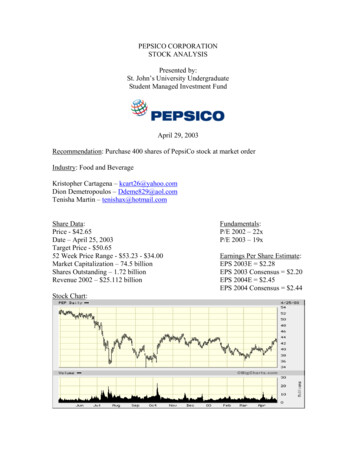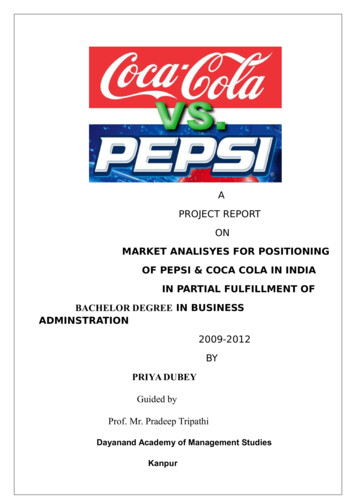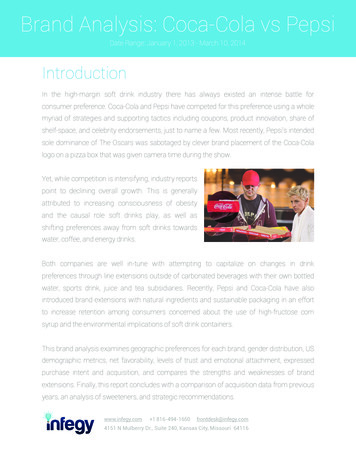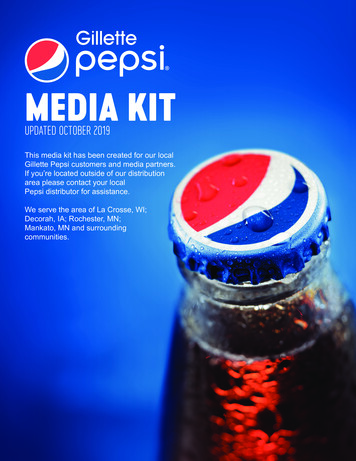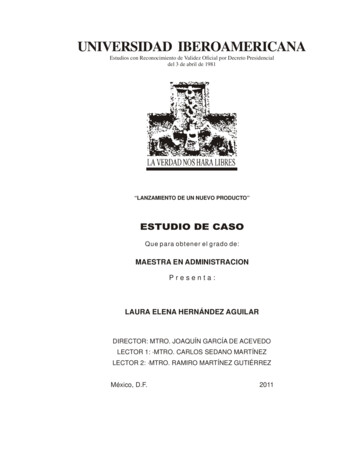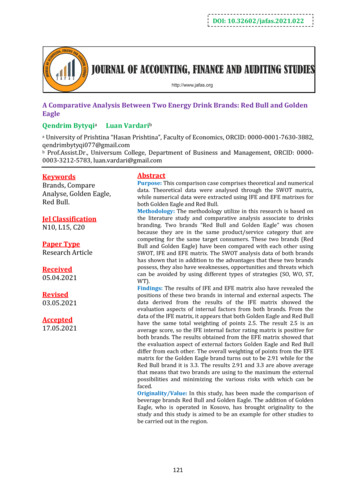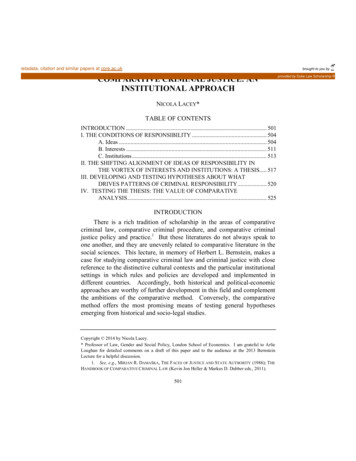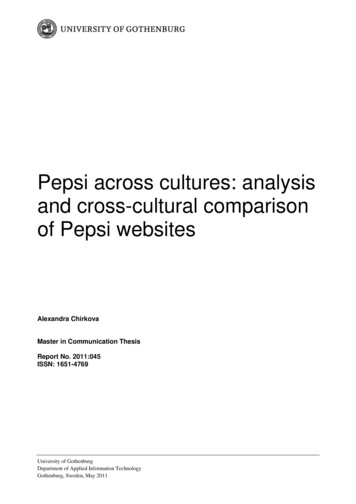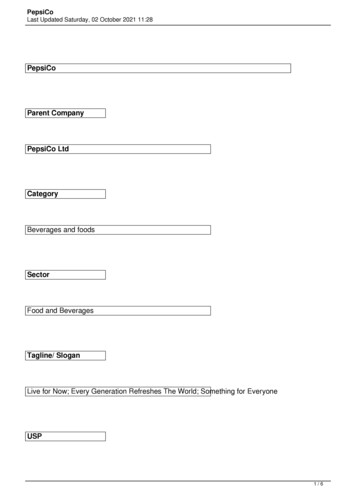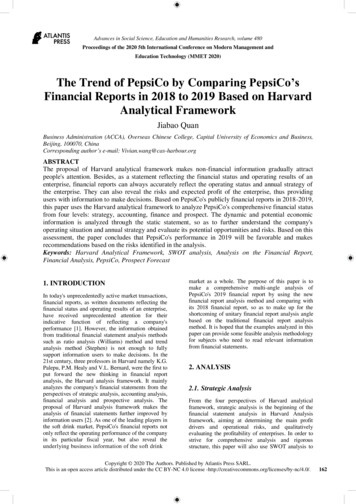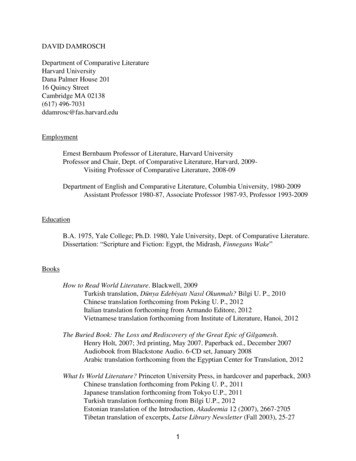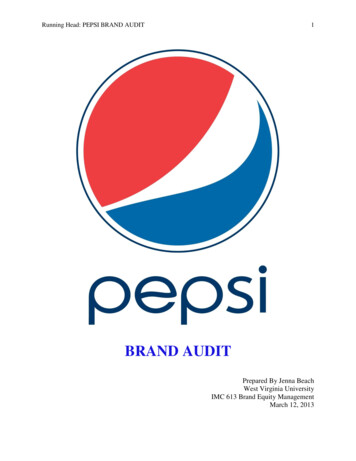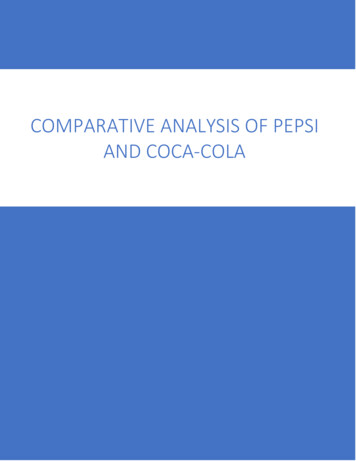
Transcription
COMPARATIVE ANALYSIS OF PEPSIAND COCA-COLA
EXECUTIVE SUMMARYThe purpose of carrying out a comparative analysis between any two companies is to evaluatetheir strengths and weaknesses as well as business patterns to find out their performance in themarket over the past few years. This comparative analysis helps companies learn and grow fromtheir weaknesses and develop an even more strong strategy over time.The soft drink also known as non-alcoholic beverage industry is dominated clearly by two namesin the market ever since we have known. Pepsi and Coca Cola. These two companies arespending their revenues and exceptional marketing strategies for more than a century now tooutdo each other in the competitive world. Both of them have a very high market share with a setof strength and weaknesses that vary and the reason that both of them have been surviving thecompetition ever since is different approaches to somewhat same destination (Cuthbert., 2019).This paper finds out the competitive strategies carried out by the above-mentioned companiesduring the cola war in the past years. Depending on the decisions made and strategies chosen byboth companies this paper evaluate how various frameworks and business strategies used by bothcompanies have affected their position in the market and made one of them to be better in themarket than other. The analysis begins with a basic introduction of these companies in themarket followed by a historical background of both the companies and the present stance in themarket. Secondly, the market analysis of both the brands is done separately to form a clear imageof different routes taken by each of them. Later on, with complete detailed survey of Pepsi andCoca Cola a comparative analysis as to which one is lagging behind and some recommendationsfor that company to outdo the other will be discussed.
Table of ContentsEXECUTIVE SUMMARY . 1INTRODUCTION . 3COMPANY OVERVIEW . 7Coca Cola . 7HISTORY . 7BUSINESS MODEL . 8Pepsi . 12HISTORY . 12BUSINESS MODEL . 13Comparative Analysis of Pepsi And Coca Cola based on SWOT Analysis . 15SWOT ANALYSIS . 15SWOT Analysis of PEPSI CO . 15SWOT Analysis of Coca Cola . 16RECOMMENDATIONS . 17REFERENCES . 19
INTRODUCTIONThe soft drink industry is not a new one in the market. It won’t be wrong to say that thesebusinesses rule over a considerable portion of the market. In the urban culture use of soft drinkshas been growing rapidly and there is no news to whether it will decline in the next few years.The reason behind this that in urban areas where people mostly carry out their dinner parties andoccasions with soft drinks. The marketers are developing new strategies which improve themanufacturing, marketing, transportation aspects of their soft drink business and keep them atthe top of the table. Moreover, the competition framework for such companies is considerablydifferent from others. The main win is achieved through how well a company perform in costing,customer centric approach and enticing audience through their unique tactics. Over the past fewyears, we have seen some of the most amazing advertisements that are known to mankind whichspecifically target the audience with the purpose of calling them towards the brand. In today’shighly competitive market there are two names known for delivering the best services andremaining at the top alternatively. Pepsi and Coca Cola. Through the years these two companieshave been grabbing every opportunity to catch on the weakness of the other and using it to thebest advantage of itself (Haldipur, Competitive Analysis Between Coke and Pepsi, 2015).If a company has to survive in the market it should be able to keep up with the advancements andsurvive the competition with the similar companies. A successful competition strategy keeps inmind the weaknesses of the competitors while avoiding the strength. This close observation ofweaknesses gives one company a winning advantage over the other. there are several waysthrough which a company can have a competitive advantage over the other. Strategies such asdifferentiation, differentiation focus, cost focus and cost leadership help process how to win thecompetition in the market (Competitive Strategies for Coca-Cola and PepsiCo Companies, n.d.).
these four strategies are different ways used by marketers to gain an upper hand over the othercompany.For instance, in differentiation, a company strives to produce goods that are different from itscompetitors. With a distinguishing feature that sets them apart the company attacks on theaudience’s perception of delivering something new. In this case one of the either Coca Cola orPepsi might want to produce a little different product by altering the ingredients. Or may addsomething that increases the value of overall product thus set a higher price for it. this improvedquality may achieve the attention of consumers by impressing them in producing a good that isbetter and safer for their health. This increased price also covers up the cost of production thusincreasing the profit.In the differentiated focus the company varies its production from that of its competitor in anarrow market range only. This strategy should be ideal for businesses who are focusing ontargeting a wider group of audience with variable taste and preferences. In this type of strategy, acompany would focus on other aspects of a product from taste to develop a sense of attraction inthe customers. For example, Pepsi may slightly vary their packaging to that of Coca Cola andfocus on an attractive design that would provide them the benefit of increased sales.On the other hand, the cost leadership strategy focuses on producing a product in lowest possiblecost. By lowering the cost of a product from its competitor a company can sell in more quantitythus gaining an advantage over their rival. For example, Pepsi introducing offers and discountsor buy one get one free business strategy on events like thanksgiving and other festivities. Insuch cases, until the attained trade amount is equal or even near to the market price, Pepsi canrelish a greater profit due to increased economies of scale.
Lastly, cost focus strategy allows setting up a lower price on the similar product in certainsections of the market. This generally happens in large scale production only. The company maydecide to set up variation in prices for the same product depending upon the type of customers.for example, introducing student discounts or discount for nurses and doctors to show them theycare. This is one of the most successful marketing tactics a company can pursue (CompetitiveStrategies for Coca-Cola and PepsiCo Companies, n.d.).Companies use hundreds of dollars along with years of experience to invest in developingwinning strategies for them. These wins can need to checked and balanced as the market statenever remains constant. That’s the thing about business, one day a brand is up next days itsdown, to ensure the later does not happen a business should be willing to strive at all times tofirst gain then maintain the position it has secured over years. When it comes to victory of a softdrink business there are 4 major defining factors. Availability Visibility Cooling RangeAvailabilityMarketers are well aware that purchasing of a soft depends on various factors. No one reallyplans on stocking up a soft drink in their monthly or weekly grocery items, rather its animpulsive decision. This impulsivity is dependent on the sudden urge of having a cold drinkin hot weather or even to serve during a family feast. Now when it comes to purchase of a
soft drink the major decision is dependent on its availability. If the stores are stocked up witha particular soft drink chances are people will opt for it more than any other choice.VisibilityOften times we observe grocery stores or even basic shops with billboards sponsored byPepsi or Coca Cola. Or even refrigerators are pasted with Pepsi logo. The purpose of this isto increase the visibility of a product. Without visibility, a product’s availability is of no use.That’s why companies use these tactics to entice customers and urge them to buy theirproduct at the first glance.CoolingThe whole purpose of a soft drink is to cool down the body heat or to enjoy it with hot food.A soft drink which is chilled in a shop would be sold more than a drink which is kept incartons. This factor contributes majorly to the sales of a soft drink.RangeA range of a product is defined by its availability in different sizes to serve a wide range ofcustomers. from a single person buddy pack to large jumbo drinks are ideal for people withlarge groups as well. This range also gives an impression to customers that they are savingmoney while getting more quantity in less amount (Haldipur, Competitive Analysis BetweenCoke and Pepsi, 2013).
COMPANY OVERVIEWCoca ColaHISTORYThe history of Coca Cola can be traced back to 8th May 1886, when pharmacist Dr. John S.Pemberton mixed natural elements: caffeine, coca leaves also known as cocaine and syrup tocreate a medicine. He invented this combination at Jacob’s pharmacy and asked the visitors tohave a free taste. Upon tasting, customers were really awes trucked with the amazing flavor ofthe mixture. Seeing this, the pharmacy started selling this mixture for five cents for each glass.Another pharmacist who worked with Mr. Pemberton, Frank M. Robinson tossed the name forthis beverage as Coca Cola, while also taking up the honor of designing its first every logo. Thesame logo is continued by the company up till now. As the drink began to gain its popularity,each day almost 9 glasses were sold which led to a gross profit of 164.25 during the first year.Since then Coca Cola which is now functioning as Coca-Cola Company Inc. has developed morethan 10 billion gallons of syrup worldwide (Competitive Analysis of Coca-Cola: PEST andPorter’s Five).Later in 1893 January, Coca Cola got registered with the U.S. patent office. And following theregistration, in 1915 the company created its renowned contour glass bottle which remained verypopular among the customers and led to huge rise in sales. By the year 1917, Coca Cola hadbecome the most widely known trademark company with a highest of 3 million Cold drinks soldper day. However, the founder did not live long enough to witness the success of his company.Now, Coca Cola was a famous beverage amongst most users and it gained even more popularityduring the World War II. The reason as to why Coca Cola gained more audience than ever was
its promise to deliver Coke to every U.S soldier during the war. During the time period of 1930to 1936, the company had expanded its reach to Germany and it continued the business duringthe war as well. The company image was recreated again as a German company and the factoriesin Germany were allowed to manufacture Coca Cola secret ingredient recipe. Now, As theconclusion of war approached in 1945, the company ruled over 64 overseas bottling plants. Itwas during the same year that the company listed on Coca-Cola’s popular nickname “COKE”(Nadeem, 2010-2012).After 130 years of development to this beverage, the Coca Cola started ruling the market majorlyin the year 1960. The company became a global icon and now is known as the number 1company leading as a non-alcoholic beverage seller in the industry. Coca Cola company Incoperates in approximately 200 countries and has a license for more than 500 brands of sparklingand other beverages. Moreover, Coca Cola also has formed an association with more than100,300 bottling partners world wide and rank amongst the top 10 private owners with a numberof more than 700,000 people working for them in all parts of the world. According to statistics,the Coca Cola business has a selling average of 1.9 billion products each day (CompetitiveAnalysis of Coca-Cola: PEST and Porter’s Five).BUSINESS MODELThe basic motivation followed by Coca Cola company is to create a difference in the worldthrough its business and marketing. Coca Cola considers itself responsible for spreadinghappiness and joy amongst the people. Their promises are based on 6 P’s which define theircompany values and core objectives.
People: Coca Cola Company promises to be an amazing place where people areencouraged to grow into best version of themselves. Portfolio: Producing quality beverages that fulfill people’s requirements. Partners: Have a strong system of customers and suppliers, to create a strong identity. Planet: To act as a accountable citizen who makes a change by building strongcommunities. Profit: While staying true to company’s core values, maximize the long tern return. Productivity: Become a highly operative and growing organization (The Coca-ColaCompany Reports Solid Operating Results in Third Quarter 2017, 2017).In addition to these core values, Coca Cola has a widespread network of management dividedinto six major active groups which can be divided into the below mentioned categories. Europe, Middle East and Africa – Sales: 29% and Profit: 7.21% Asia Pacific – Sales: 28% and Profit: 4.92% North America – Sales: 23% and Profit: 4.30% Latin America – Sales: 20% and Profit: 3.78% Corporate – Sales: 14% and Profit: 0.07% Bottling Operating Segment: – Sales: -16% and Profit: -3.70% (The Coca-Cola CompanyReports Solid Operating Results in Third Quarter 2017, 2017).The first five of these units are considered to be company’s planned business units. Eachstrategic unit is appointed a head who then reports to the Chief Operating Officer. The chiefoperating officers then have to collectively inform regarding the operations to the ChiefExecutive Officer and also to the Chairman of the Board of Directors. Coca-Cola works on a
decentralized structure while having a chief authority where all sub units report. Oneimportant aspect of Coca Cola core values is environmentalism. The company promises andthen keeps up with the environmental regulations (Cuthbert., 2019).The use of beverages despite related medical concerns has remained very popular in the pastand there is no visible decline in the consumption as well. The Coca Cola’s portfolio is verywide which gives it the benefit of serving a large group of audience. Coca Cola’s portfoliocomprises of about 21 brands with a sale more than 1 billion including various extensions tothe product. These products include Coke, Diet Coke, Coke Zero, Sprite, Dasani, Fanta,Powerade and Minute Maid. This diversification in portfolio enables it to satisfy the needs ofwide group of audience from all around the world.Even with such variety, the company has been facing a little decline in their sales which isalso combined with slow growth. To overcome this issue, the company is in the midst of refranchising by selling its US distribution and manufacturing operations. During the year2015, Coca Cola cut off around 1500 jobs worldwide by stripping its bottling operations toreduce 3 billion dollar in cost. Now the firm has brought up some organizational changesand the chances are that by altering the elementary portion of their business model, theassociation can avail more facilities in the market and remain at a strong position in future aswell (Competitive Analysis of Coca-Cola: PEST and Porter’s Five).This change refers to the evolution of their current “Creative Excellence” marketing strategyto be evolved into “Content Excellence”. This is the recent logic behind developing awinning strategy by the company. Introduced by Marry Minnick (Executive vice presidentand president of marketing, strategy and innovation, Coca-Cola U.S, n.d.) has developed this
idea to transform the market and structure of the Coca Cola brand. The marketing ideologiesdeveloped by Marry Minnick has used the customer centric approach to increase and boostthe sales. She has utilized Customer expectancy, Retooling of Old Brands, AppealingPartners, Retailer’s Response, Liability and Advertising (Competitive Strategies for CocaCola and PepsiCo Companies, n.d.).
PepsiHISTORYThe origin of Pepsi can be traced back to New Bern, North Carolina where a pharmacist namedCaleb Bradham used to operate a soda fountain along with a drug store. He repeatedly tried amixture of various ingredients to create a soft drink that could sell itself due to the taste andquality which impresses everyone. One of his such experiments gained popularity among thelocals which was recognized as Brad’s Drink. This was the same drink which was later named asPepsi in 1898. The first time Pepsi was advertised in a newspaper was in 1902. Thisadvertisement focused on highlighting the health benefits of the Pepsi. Later in 1903, Pepsi’sname was listed with the United States Patent and Trademark Office. In 1905, Pepsi was sold inbottles as a chilled drink. This was due to the advancements in the soft drink industry, whichmade bottling a viable alternative to cold drinks. Looking at this opportunity, Bradham offeredbottling franchises for his beverage. And by the year 1909, there were almost 250 Pepsi bottlersdistributed in around 24 states (Stoddard, 2013).To talk about another perspective from later times, the company was initiated in 1965, in NewYork with the ultimate goal of producing non-alcohol drinks and food processing items. It is thenumber one snacks producer worldwide. The company deals in light foods and operated aroundthe US and Canada. The initial startup of the business was through only two operating unitswhich were Pepsi co North America and Pepsi Co international. Soon the company realized, togrow financially and in the market, it needs to have a stronger wide spread of networks so itdeveloped three more branches. These three networks operate in different regions. The firstbranch primarily functions in the Latin America whereas the second division, the Pepsi cointernational has a more global operating approach. The third branch is named as Pepsi co
Americas beverages and carries out its operations in North America, Tropicana, Gatorade andLatin America. This leads to the company having a decentralized structure (Cuthbert., 2019).BUSINESS MODELThe reason behind Pepsi’s popularity and high market share is that it never compromises onquality. Pepsi has focused on protecting their customer’s trust and values and to keep them inconfidence. Pepsi does not sell a product without a quality assurance label on it. it also strictlyfollows environmental regulations to act as a responsible part of the society. When it comes tomarketing strategy, Pepsi has proved to be one of the best through series of advertisements thatare second to none. Pepsi usually focuses on influential marketing and promoting their productsthrough celebrities (Cuthbert., 2019).When it comes to marketing strategy Pepsi has always targeted the young audience. the famousslogan of Pepsi “The Choice of new generation” denotes that Pepsi puts the interest ofyoungsters before anything else. This has led to a likeliness of Pepsi mostly among the younggenerations who in turn are the biggest fans of soft drinks. Besides having an attractive sloganPepsi also does several efforts to attract youngsters towards their product. Every year Pepsiinvites celebrities and influencers who are very popular among the young generation. One suchexample is Michael Jackson, who was endorsed with the Pepsi brand for a really long time.Furthermore, Pepsi also had endorsed worldwide famous starts including Britney Spears,Shaquille O’Neal and Maria Carey to promote their products. Secondly, we all have seen Pepsi isalways connecting their marketing strategy with music. Since, everyone is the fan of pleasingsounds, Pepsi uses attractive songs to entice young generation and bring up the adrenaline rush.
In fact, Pepsi also holds some musical concerts every year with Pop music which is most popularamong the users. The third way is that Pepsi advertises its products through small accessories,such as bands, fashion products and collectibles to attract young customers. These productswhich are other than food and beverages show young generation that brand is concerned abouttheir interest (Muzumdar).
Comparative Analysis of Pepsi And Coca Cola based on SWOT AnalysisSWOT ANALYSISSWOT Analysis abbreviates for Strength, Weakness, Opportunities and Threats analysis whichare involved in a project or a business. It is used to learn about the external and internal factors,the internal factors cover Strength and Weakness whereas external factors compriseOpportunities and Threats. This is the basic way of comparing and evaluating how businesses areperforming in the market.SWOT Analysis of PEPSI COStrengths 2nd largest beverage and Food business in the world Pepsi has a strong worldwide brand image Strong operational efficiency Extensive and innovative product lineWeaknesses Tough race with Coca-Cola Coca Cola has a relatively greater share of soft drinks in the US Dependent on retailers largely A Strong employees union Image damage due to product recallOpportunities Growth in product lines, Pepsi can introduce more products
More networks into developing countries Can gain more bottling companiesThreats Failure to obey with environmental guidelines and production contamination Constant changes in foods and drugs laws relating to import and export of products Variations in interest charges, taxes and inflation (Muzumdar).SWOT Analysis of Coca ColaStrength Most Popular soft drink brand in US Several Coca-Cola based products are manufactured and sold More than 600 million product consumption each dayWeaknesses Reduction in sales volume worldwide Franchising of some share of company Sales in Japan fell, Japan consumes 35% of Coca ColaOpportunities Strong brand image with a world wide recognition Can serve a large geographical base Has more opportunities to grow with changes in product and packagingThreats
Competitive threat from Pepsi co Has many other substitutes Health concerns which reduce the beverage consumption (Cuthbert., 2019)RECOMMENDATIONSCoca Cola is facing substantial decrease in its market share due to a poor market strategy. Asdiscussed above, Pepsi has a stronger marketing tactics and uses it to the best advantage to attractvarious audience throughout the world. When it comes to Coca Cola, the company has a lackingin decision making which makes it suffers in the market. Coca Cola should follow adecentralized approach that divides the company into different segments working dividedly fordecision making depending on various parts of the world. Coca Cola also needs to develop astrong bottling market which could give rise to its market share tremendously. The company, asseen has a huge potential and resources to improve its growth in the market but without a properstrategy the company cannot achieve the success it should. Political uncertainty is unavoidable,particularly in the countries which are not properly developed, and thus markets that not meet thedemands of Coca Cola industry. In order to prevent this, Coca-should take into account theparticular context in which it works in terms of history, politics and the economies of theparticular markets. Changing customer behavior is still a challenge and, thus, to combat it, CocaCola will continue to promote its soda products as the demand begins to expand rapidly.
Figure 1 Pepsi Vs Coca Cola (Parthenidou, 2019)This comparative analysis proves that Pepsi Co has made substantial growth in the market evenafter being launched several years after Coca Cola as shown in the figure above. Pepsi co is acompany with long term vision and profit goals that are liked by customers and have acomparatively bright future when it comes to successful market strategies (Cuthbert., 2019).
REFERENCES1. (n.d.). Competitive Analysis of Coca-Cola: PEST and Porter’s Five. UKdiss.com.2. Competitive Strategies for Coca-Cola and PepsiCo Companies. (n.d.). Retrieved rategies-for-coca-cola-and-pepsico-companies/3. Cuthbert. (2019). Comparative analysis of Coca-Cola Company and PepsiCo of-coca-cola-company-and-pepsico/.4. Executive vice president and president of marketing, strategy and innovation, Coca-Cola U.S.(n.d.). Retrieved from forbes: https://www.forbes.com/fdc/welcome mjx.shtml5. Haldipur, V. (2013). Competitive Analysis Between Coke and Pepsi. Scribd.6. Haldipur, V. (2015). Competitive Analysis Between Coke and Pepsi. Scribd.com.7. Muzumdar, P. (n.d.). A Study of Business Process: Case Study Approach to PepsiCo. TheUniversity of Texas at Arlington.8. Nadeem, A. (2010-2012). SUMMER TRAINING PROJECT REPORT ON COMPARATIVE ANALYSIS OFMARKETING STRATEGY OF COCA COLA AND PEPSICO. Gautam Buddha Technical University,Lucknow.9. Parthenidou, C. (2019, April 22). Coca-Cola on watch after PepsiCo’s earnings beat – StockMarket News. Retrieved from Stock Market News: s-earnings-beat-stock-market-news-10025410. Stoddard, B. (2013). The Pepsi-Cola Story. Bob Stoddard and the Pepsi-Cola Company.
11. The Coca-Cola Company Reports Solid Operating Results in Third Quarter 2017. (2017, October24). Retrieved from The Coca Cola Company: 17
Since then Coca Cola which is now functioning as Coca-Cola Company Inc. has developed more than 10 billion gallons of syrup worldwide (Competitive Analysis of Coca-Cola: PEST and Porter's Five). Later in 1893 January, Coca Cola got registered with the U.S. patent office. And following the
